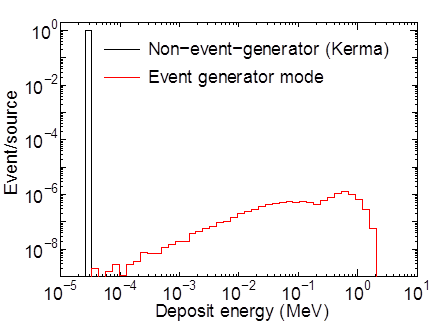
Home | News | How to Get | How to Use | library | Tutorial schedule | Update log | FAQ | Reference | Contact | 日本語版
| Overview |
|---|
2. Current Status 3. Physical Models 3.1 Map of Models 3.2 JAM 3.3 JQMD 4. Special Features 4.1 Event Generator 4.2 Microdosimetric Function |
| Special Features > Event Generator Mode |
|---|
Energy and momentum are not conserved in an event of transport calculations based one-body Bolzmann equation with the nuclear data base if there are more than 2 particles in the final state. They are conserved as an average over many Monte Carlo events. Moreover, solutions of Boltzmann equation include only mean values of the one-body observables in the phase space. It cannot give us two-body and higher correlations, since Bolzmann equation and also the nuclear data base has no information for the two-body and higher correlations. A typical example of such higher correlation is deposit energy distribution treated in [T-Heat] tally. This cannot be calculated by one-body Bolzmann equation. For high enregy nuclear reactions, there is no enough evaluated data base. Then we employed some nuclear reaction models, such as JAM and QMD. These reaction models can describe all ejectiles of the reaction keeping the energy and momentum by the Monte Carlo method.Therefore we can extract any information from the transport calculation with these reaction models. In this sense, these transport codes are called as "event generators". In PHITS, we have two domains, event generator for high energy and transport for low energy with the nuclear data. Recently, even in low energy fields, the correlated quantities, such as the deposit energy distribution, are often required, for examples, estimations of single upset error of semiconductor, biological effects and in a microdosimetry field. For these requirement, we changed the transport algorithm for low-energy neutrons from that based on solving Boltmann equation (in a similar manner as MCNP) to the original one based on the concept of the event generator, and developed an "event generator mode" for all energy region in PHITS [1-2]. This mode is chosen by "e-mode=1" in the parameter section. References: [1] K. Niita et al. Int. Conf. Nucl. Data for Sci. Tech. 2007, DOI: 10.1051/ndata:07398 [2] Y. Iwamoto et al. Int. Conf. Nucl. Data for Sci. Tech. 2007, DOI: 10.1051/ndata:07417
Deposition energy distribution in 3 micron Si irradiated by 19 MeV neutrons calculated by PHITS using event generator mode and non-event generator mode, namely Kerma approximation. Kerma approximation just gives the average value of the deposition energy for each event. |
Copyright(C) 2007- Japan Atomic Energy Agency, All Right Reserved.
